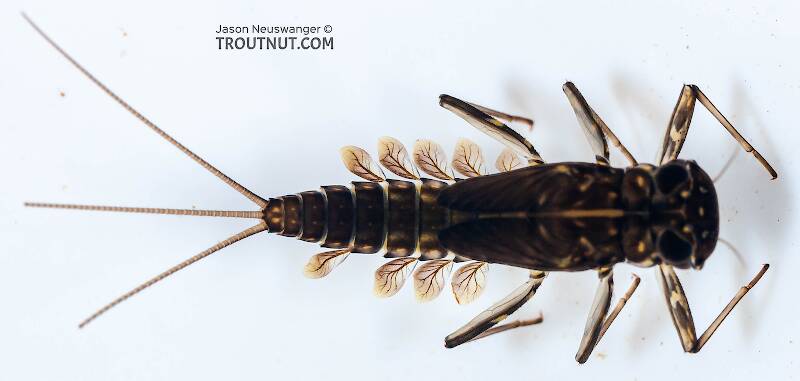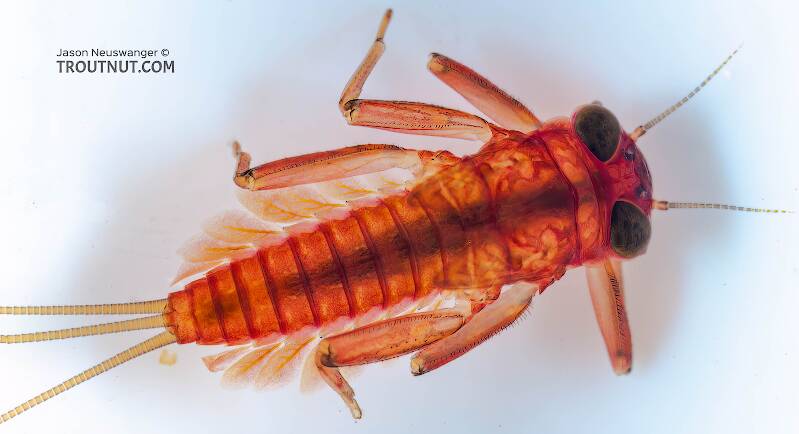
Blue-winged Olives
Baetis
Tiny Baetis mayflies are perhaps the most commonly encountered and imitated by anglers on all American trout streams due to their great abundance, widespread distribution, and trout-friendly emergence habits.

— 4 small yellow spots on frons visible in photos
— Narrow occipital spinule row curves forward (but doesn’t quite meet on stem of ecdysial suture, as it's supposed to in this species)
— Short spinules on anterior margin of front legs
— Short rposterior row of blunt spinules on abdominal tergae, rather than elongated spinules dorsally
I caught several of these mature nymphs in the fishless, tiny headwaters of a creek high in the Wenatchee Mountains.

Mayfly Species Cinygmula subaequalis (Small Gordon Quills)
Where & when
Cinygmula subaequalis is widespread but only locally abundant. Caucci and Nastasi in their collections for Hatches II were unable to find any specimens, but Fred Arbona in Mayflies, the Angler, and the Trout mentions consistent subaequalis hatches in the mountains of Pennsylvania, New York, and Vermont.In 34 records from GBIF, adults of this species have mostly been collected during June (50%), July (24%), May (18%), and August (6%).
In 21 records from GBIF, this species has been collected at elevations ranging from 240 to 2746 ft, with an average (median) of 2280 ft.
Species Range
Physical description
Most physical descriptions on Troutnut are direct or slightly edited quotes from the original scientific sources describing or updating the species, although there may be errors in copying them to this website. Such descriptions aren't always definitive, because species often turn out to be more variable than the original describers observed. In some cases, only a single specimen was described! However, they are useful starting points.
Male Spinner
Wing length: 8 mm
Head reddish yellow; “a shining black ring at base of each ocellus, antennae pale” (Bks.). Thorax rather reddish yellow, posterior portion of notum darker. Legs pale, “a black dot at tip of femur and tibia I" (Bks.). Wings hyaline; venation mostly brown, no cross veins dark-margined; stigmatic area brownish yellow. “About five costals before bulla, fourteen beyond, a few near the middle are crossed” (Bks.). Hind wings not dark-margined. Basal joint of fore tarsus of male fully two-thirds as long as second; third equal to second; fourth “‘scarcely longer than first, the fifth not one-third of first.” (Bks.). Abdomen pale; “segments dark on apical one-third or one-half above, last three segments brownish” (Bks.) Forceps pale. Tails faintly dark.
Described as C. atlantica
Body length 7 mm, wing length 8 mm
A rather small pale species; wings not tinted; spines on lower outer margin of penes.
Head yellowish brown; dark brown between eyes. Thorax light brown; lateral areas of pronotum, and postero-lateral areas of mesonota and metanota, shaded with darker brown. Fore legs smoky brown. Middle and hind legs yellowish brown. Wings hyaline, not tinted; all veins fine, brown. Abdominal tergites 2-6 semi-hyaline, pale, with brown shading laterally. Tergites 2 and 3 pale in central median area only; tergites 4 to 6 largely pale, the brown shading restricted to postero-lateral areas. Submedian pale dashes, partially outlined in brown, are faintly indicated. Sternites pale ochreous, 2-6 semi-hyaline, 7-9 opaque. Tergites 7-10 opaque, almost wholly brown. Tails pale brown; penes smoky brown. A spine is present on lower outer margin of penes on each side, but none in inner margin (see fig. 103).
This species is allied to Cinygmula par, by the structure of the genitalia, but it lacks the inner spine on the penes found in that species. The paler abdominal tergites and lack of mid-ventral dark markings in C. atlantica serve to distinguish it from C. par.
Specimens of the Mayfly Species Cinygmula subaequalis
2 Nymphs
Start a Discussion of Cinygmula subaequalis
References
- Arbona, Fred Jr. 1989. Mayflies, the Angler, and the Trout. Nick Lyons Books.
- Caucci, Al and Nastasi, Bob. 2004. Hatches II. The Lyons Press.
- Needham, James G., Jay R. Traver, and Yin-Chi Hsu. 1935. The Biology of Mayflies. Comstock Publishing Company, Inc.
Mayfly Species Cinygmula subaequalis (Small Gordon Quills)
Species Range
Common Names
Resources
- NatureServe
- Integrated Taxonomic Information System
- Global Biodiversity Information Facility
- Described by Banks (1914)



